
Lafitte's Blacksmith Shop is a historic structure at the corner of Bourbon Street and St. Philip Street in the French Quarter of New Orleans, Louisiana. Most likely built as a house in the 1770s during the Spanish colonial period, it is one of the oldest surviving structures in New Orleans.

The Pitot House is a historic landmark in New Orleans, Louisiana, and is listed on the National Register of Historic Places.

Laura Plantation is a restored historic Louisiana Creole plantation on the west bank of the Mississippi River near Vacherie, Louisiana, (U.S.), open for guided tours. Formerly known as Duparc Plantation, it is significant for its early 19th-century Créole-style raised big house and several surviving outbuildings, including two slave cabins. It is one of only 15 plantation complexes in Louisiana with this many complete structures. Because of its historical importance, the plantation is on the National Register of Historic Places. The site, in St. James Parish, Louisiana, is also included on the Louisiana African American Heritage Trail.
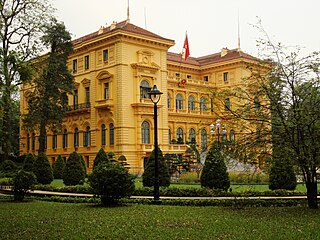
French colonial architecture includes several styles of architecture used by the French during colonization. Many former French colonies, especially those in Southeast Asia, have previously been reluctant to promote their colonial architecture as an asset for tourism; however, in recent times, the new generation of local authorities has somewhat "embraced" the architecture and has begun to advertise it. French Colonial architecture has a long history, beginning in North America in 1604 and being most active in the Western Hemisphere until the 19th century, when the French turned their attention more to Africa, Asia, and the Pacific.

Creole architecture in the United States is present in buildings in Louisiana and elsewhere in the South, and also in the U.S. associated territories of Puerto Rico and the U.S. Virgin Islands. One interesting variant is Ponce Creole style.

Ursuline Convent was a series of historic Ursuline convents in New Orleans, Louisiana. In 1727, at the request of Governor Étienne Perier, nuns from the Ursuline Convent of Rouen (Normandy) went to New Orleans to found a convent, run a hospital, and take care of educating young girls.

Poteaux-sur-sol is a style of timber framing in which relatively closely spaced posts rest on a timber sill. Poteaux-en-terre and pieux-en-terre are similar, but the closely spaced posts extend into the ground rather than resting on a sill on a foundation, and therefore are a type of post in ground construction. Poteaux-sur-sol is similar to the framing style known in the United Kingdom as close studding. Poteaux-sur-sol has also, confusingly, been used for other types of timber framing which have a sill timber such as post-and-plank, but this is considered incorrect by some scholars.

The Ste. Genevieve National Historical Park, established in 2020, consists of part or the whole of the area of the Ste. Genevieve Historic District, which is a historic district encompassing much of the built environment of Ste. Genevieve, Missouri, United States. The city was in the late 18th century the capital of Spanish Louisiana, and, at its original location a few miles south, capital of French Louisiana as well. A large area of the city, including fields along the Mississippi River, is a National Historic Landmark District designated in 1960, for its historically French architecture and land-use patterns, while a smaller area, encompassing the parts of the city historically important between about 1790 and 1950, was named separately to the National Register of Historic Places in 2002.
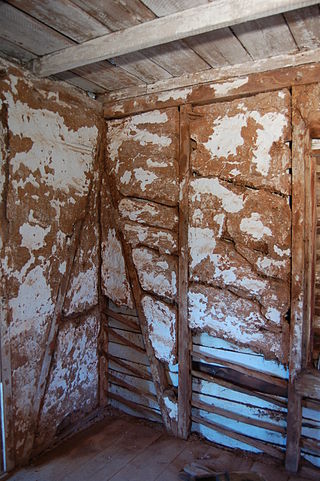
Bousillage is a mixture of clay and grass or other fibrous substances used as the infill (chinking) between the timbers of a half-timbered building. This material was commonly used by 18th-century French colonial settlers in the historical New France region of the United States and is similar to the material cob and adobe. In French torchis has the same meaning or the meaning of a loaf of this material.

The Camp Salmen House is located on the shores of Bayou Liberty in St. Tammany Parish, west of Slidell, Louisiana, USA. It is a French Creole cottage, circa 1830. The house was built with a brick core, wood frame post rooms, a cabinet/loggia, and front gallery. The entire structure, including the front gallery, is approximately 1,692 square feet. The house was placed on the National Register of Historic Places on April 24, 2006. It is one of only fourteen examples of the period French Creole architecture in the parish. The National Register of Historic Places listings in St. Tammany Parish, Louisiana lists 38 historic places in St. Tammany Parish.

The Francois Cousin House near Slidell is located in eastern St. Tammany Parish, Louisiana, west of the City of Slidell, Louisiana. The house is a French Creole Cottage, likely built between 1778 and 1790, by Francois Cousin. Cousin, born in 1745 in New Orleans, managed his father's lumber and brick making business interests on the north shore of Lake Pontchartrain. He built this home facing Bayou Liberty which has direct access to Lake Pontchartrain. Behind the home are the pits used to mine the clay. Cousin also owned property in Lacombe, Louisiana.

The Hotel St. Pierre is a collection of Creole cottages, many dating from the early 1780s, in the French Quarter of New Orleans, Louisiana, U.S.A. Its business address is 911 Burgundy Street.

The Creole House is a historic residence in the village of Prairie du Rocher, an old French settlement in present-day Randolph County, Illinois, United States. Built at the end of the eighteenth century and later expanded, the Creole House is the last survivor in Illinois of its type of vernacular architecture, and it forms an important part of the built environment of a portion of the Upper Mississippi Valley that possesses an unparalleled connection to the French settlement period.
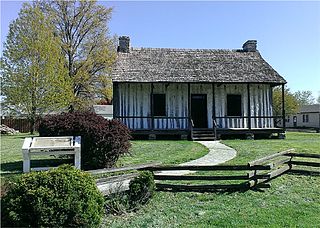
The Pierre Martin House is a single-family French Colonial House and historic site in East Carondelet, Illinois about 1.5 miles (2.4 km) East of the Mississippi River. The house, built circa 1790, is owned by the Illinois Historic Preservation Agency. and located at the intersection of First Street and Old Route 3 in North Dupo.

The Alexandre Mouton House, also called the Lafayette Museum, is a historic house located at 1122 Lafayette Street in Lafayette, Louisiana. It was the home of 11th Governor and first Democratic Governor of Louisiana Alexandre Mouton, and it is also associated with other historic families.
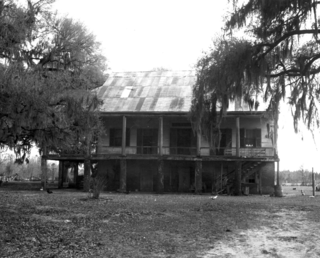
The Darby Plantation is a Southern plantation located about 2.1 miles (3.4 km) northwest of New Iberia, Louisiana.
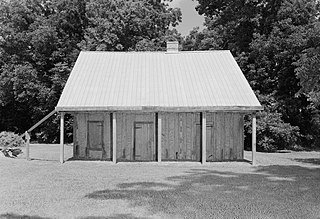
The Badin-Roque House is a historic house located along Louisiana Highway 484, about 6.6 miles (10.6 km) southeast of Natchez in the community of Isle Brevelle.

The Bertus-Ducatel House, at 1721 Lakeshore Dr. in Mandeville, Louisiana, was built around 1839. It was listed on the National Register of Historic Places in 1998.
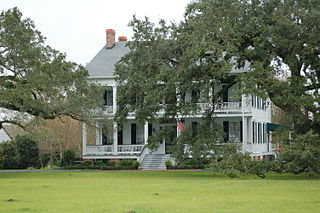
The Alice C Plantation House, also known simply as the Alice Plantation House, is a historic former plantation house, located in Garden City near Franklin in St. Mary Parish, Louisiana.

The Nicolas Janis House, also known as the Green Tree Tavern or Greentree Tavern or as the Janis-Ziegler House, is a poteaux-sur-sol French colonial style house that was built circa 1790-1791 in Ste. Genevieve, Missouri. It is the oldest verified house in Missouri by dendrochronology. The house is listed in the National Register of Historic Places as a part of the Ste. Genevieve Historic District. It is a component of the Ste. Genevieve National Historical Park, a unit of the National Park Service.





















